How to Build an MVP in 3–6 Months: A Step-by-Step Guide
Build your MVP in just 3 to 6 months with VoxturrLabs’ proven step-by-step guide. Learn timelines, team structure, agile sprints & MVP best practices to launch faster.
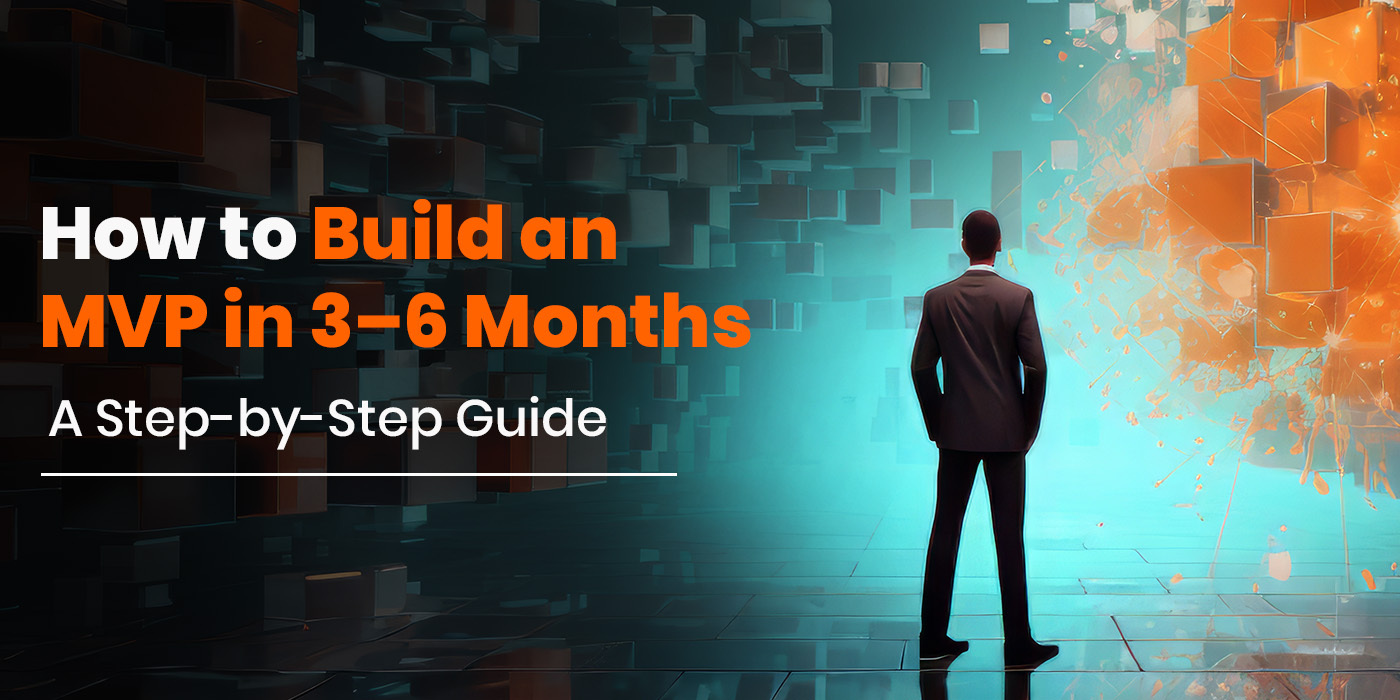 Have you ever tried to build an MVP only to discover that deadlines slip, scope explodes, and budgets balloon? You’re not alone. In CB Insights’ 2023 post-mortem of failed startups, timeline overrun ranked among the top five killers of young companies. A disciplined MVP development timeline of 3–6 months forces focus, accelerates user validation, and preserves runway.
Have you ever tried to build an MVP only to discover that deadlines slip, scope explodes, and budgets balloon? You’re not alone. In CB Insights’ 2023 post-mortem of failed startups, timeline overrun ranked among the top five killers of young companies. A disciplined MVP development timeline of 3–6 months forces focus, accelerates user validation, and preserves runway.
This guide shows you how to build an MVP, step by step, without drowning in complexity. Whether you’re a first-time founder or a seasoned product manager, you’ll find clear timelines, checklists, resource plans, and de-risking tactics you can apply tomorrow.
What Is an MVP And Why the 3-to-6-Month Window Matters
A Minimum Viable Product (MVP) is the leanest possible version of your product that:
-
Delivers one core value proposition to a well-defined user segment.
-
Collects real-world feedback you can measure in weeks—not years.
-
Validates (or invalidates) critical assumptions before heavy investment.
Why a 3 to 6 Month MVP Development Target?
-
Market Signal Freshness: User pain points shift quickly, waiting a year often means missing the wave.
-
Investor Proof: Pre-seed funds increasingly require traction within six months of capital deployment.
-
Runway Math: At a burn of $20k/month, a six-month MVP caps risk at $120k vs. multi-year, seven-figure builds.
Why MVP Matters in Product Development
When launching a new product, startups often face a common dilemma - build the full vision or test the waters first. That’s where the MVP (Minimum Viable Product) becomes essential. An MVP isn’t just a stripped-down version of your idea; it’s a smart, focused launch pad.
Building an MVP for startups helps validate core assumptions, gather early feedback, and reduce time-to-market. Instead of spending months (or years) developing features users may never need, startups use MVPs to test demand quickly and cost-effectively. According to CB Insights, 42% of startups fail because there’s no market need, an MVP minimizes this risk.
The benefits are real: lower development costs, quicker pivots, and higher chances of investor interest. Teams can launch in weeks instead of months and make informed decisions backed by real user data. It’s not about launching something “half-baked,” but about launching something “just right” to learn what truly works.
In short, if you want to build an MVP for startups that succeed, focus on value, not volume. The MVP minimum viable product approach is your ticket to smarter development, leaner operations, and higher product-market fit.
Whether you're a first-time founder or an experienced CTO, building an MVP is your best bet to reduce risk, save money, and move fast. The leaner you start, the stronger you grow.
When You Should Build an MVP
Not every idea requires a full-scale product immediately. In fact, for many businesses, especially early-stage ones, building a startup MVP (Minimum Viable Product) is the smartest first move. But when exactly should you consider it?
The answer lies in your stage and goals. If you're still validating your business idea, testing market interest, or pitching to investors, an MVP gives you traction without draining your resources. It's ideal when you're exploring product–market fit or want to learn fast before scaling.
In Agile development, the MVP plays a key role in iterative releases. By adopting an MVP agile approach, teams prioritize core functionality, gather feedback early, and make informed decisions with every sprint. It reduces the risk of building the wrong thing and encourages continuous learning.
Whether you're a solo founder with an idea or a growing team looking to de-risk innovation, the MVP helps you launch lean, learn quickly, and iterate with purpose.
If your product idea is untested, your budget is limited, or your goal is rapid validation, a startup MVP built with Agile principles is your go-to strategy. Start simple, build smart, and scale with confidence with VoxturrLabs MVP development.
Where MVP Fits in the Product Lifecycle
The MVP (Minimum Viable Product) isn't just a startup buzzword, it's a strategic tool in modern product development. Whether you're building a new product or updating an existing one, understanding where the MVP fits in the lifecycle can save you time, money, and avoid missteps.
In the MVP product development journey, the MVP typically follows ideation and precedes full-scale development. Once you've identified a problem and outlined a solution, the MVP helps you test that solution with minimal investment. It's not about launching a perfect product, it's about launching a useful one that generates feedback.
In Agile development, the MVP is the first usable increment delivered. This aligns well with Agile's iterative model: release small, learn quickly, and improve continuously. Teams that choose agile development MVP strategies can adapt rapidly, reprioritize features based on real user input, and align development with actual needs rather than assumptions.
The MVP serves as the critical bridge between an idea and its execution in any product lifecycle. For Agile teams, it's the launchpad that turns concepts into validated solutions, one sprint at a time.
High-Level MVP Development Timeline (0–6 Months)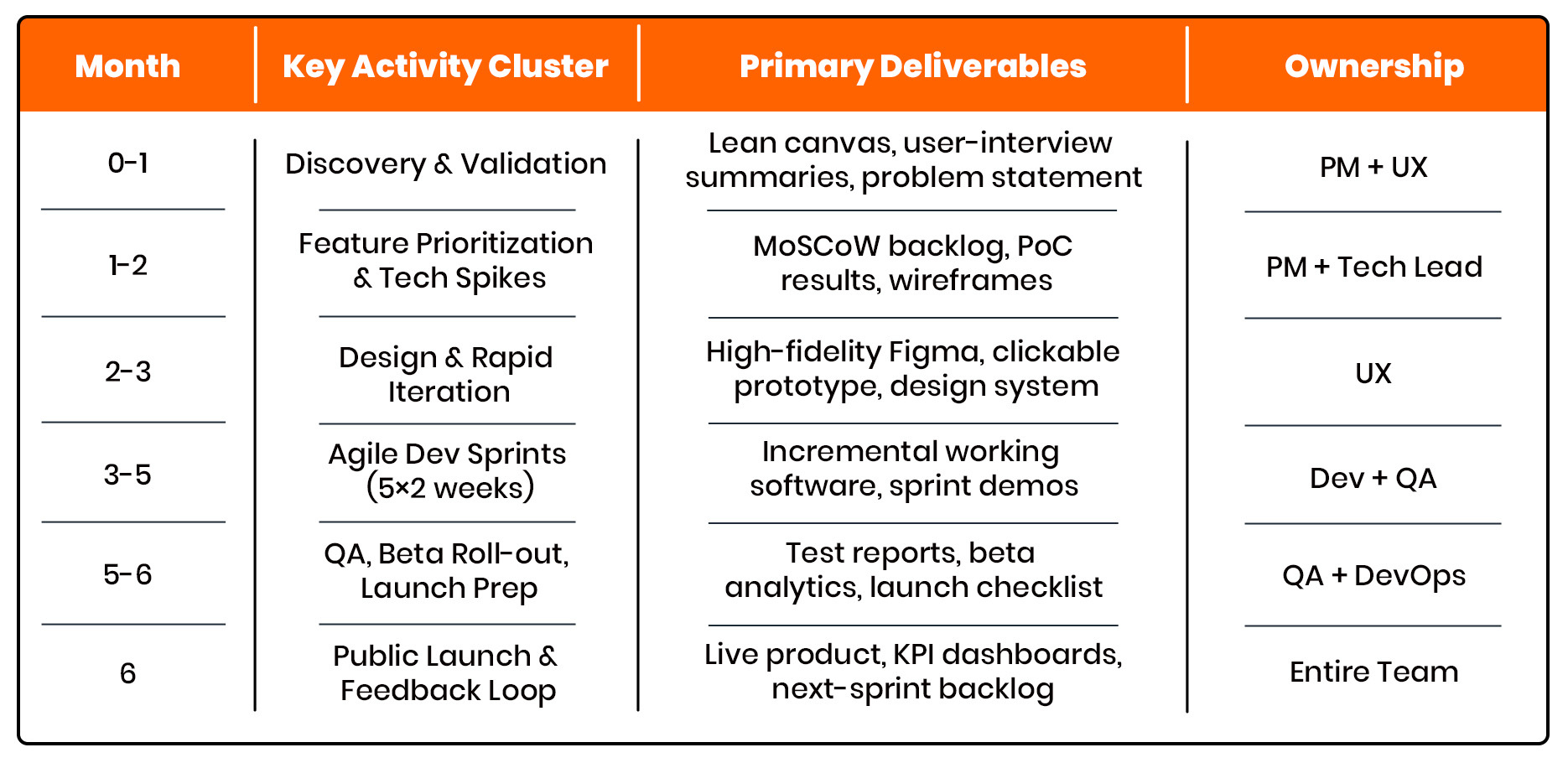
This roadmap condenses a typical MVP development timeline into manageable chunks without unnecessary overlap.
Phase-by-Phase Development Approach
Phase 1: Discovery & Validation (Weeks 1–4)
Goals
-
Validate problem–solution fit.
-
Quantify demand and willingness to pay.
Key Tasks & Benchmarks
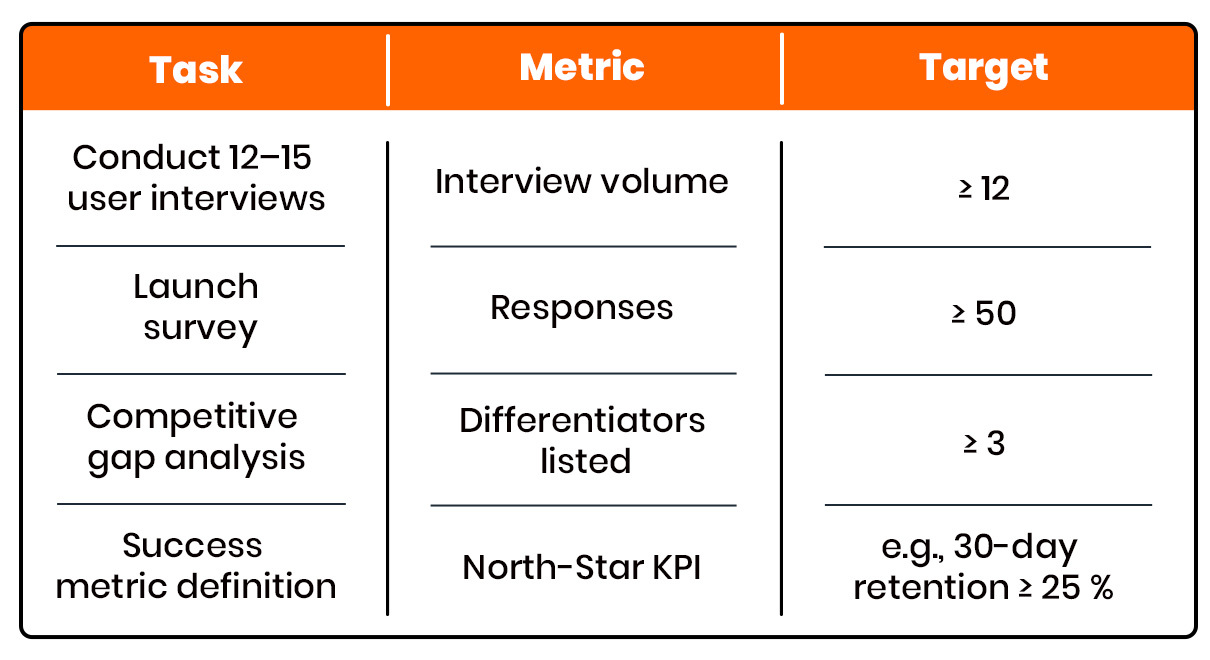
Output: A crisp value-prop, validated user personas, and an acceptance that no code is written yet.
Phase 2: Feature Prioritization & Technical Assessment (Weeks 4–8)
Prioritize first, then prototype.
-
MoSCoW or RICE scoring—rank features by impact versus effort.
-
Tech spikes/PoCs—de-risk unknowns (e.g., payment gateway latency, AI model accuracy).
-
Wireframes for top user flows in Figma or Whimsical.
Rule of Thumb: 60 % of backlog items should be Must-haves; the rest become Phase 2 or “parking lot” items.
Phase 3: UX/UI Design & Rapid Iteration (Weeks 8–12)
-
Build a design system (color, typography, components).
-
Usability testing with 5–7 targets: aim for System Usability Scale ≥ 80.
-
Iterate prototypes weekly; lock visual language by Week 12.
Phase 4: Agile Development Sprints (Weeks 12–22)
Sprint Cadence: 2-week cycles with demo on Day 10.
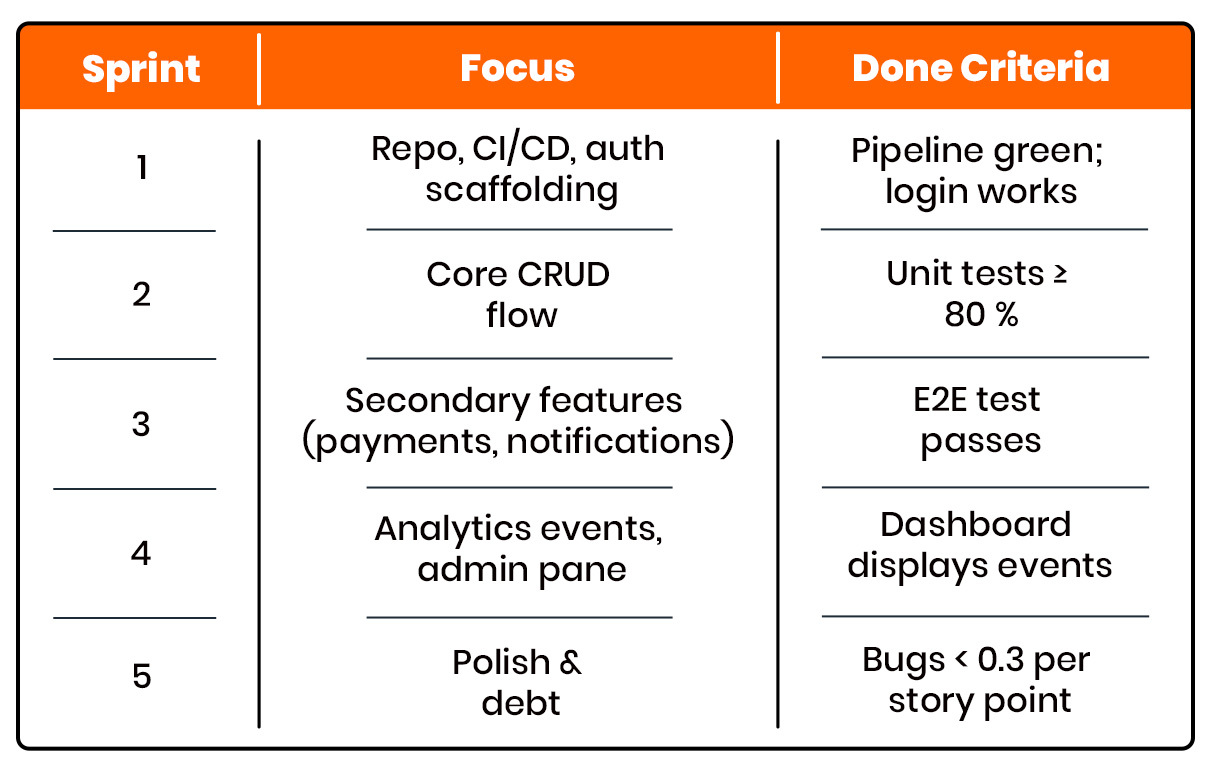
Phase 5: Testing, QA & Hardening (Weeks 22–24)
-
Manual functional suite across top devices.
-
Automated regression to guard critical paths.
-
OWASP security checklist for web/API.
-
Performance targets: P95 API latency < 400 ms; Mobile cold-start < 2.5 s.
Phase 6: Launch & Feedback Loops (Weeks 24–26)
-
Beta cohort: 100–200 users, target activation ≥ 30 %.
-
Set up Mixpanel/Amplitude funnels.
-
Public launch once churn stabilizes (< 15 % in week 2).
-
Spin roadmap into v1.1 backlog.
Resource Requirements & Optimal Team Composition
Product Manager (100% FTE)
-
Owns the product roadmap and feature prioritization
-
Manages communication with stakeholders and internal teams
-
Ensures alignment between business goals and development progress
Tech Lead / Architect (80% FTE)
-
Selects the technology stack and defines the system architecture
-
Conducts code reviews and leads technical exploration (spikes)
-
Provides technical direction to the development team
Full-Stack Developers × 2 (100% FTE each)
-
Responsible for core feature development
-
Write and maintain unit tests
-
Collaborate closely with the designer and QA
UX/UI Designer (50% FTE, front-loaded)
-
Conducts user research to inform product direction
-
Designs wireframes, prototypes, and user flows
-
Supports implementation during early development phases
QA Engineer (50% FTE, back-loaded)
-
Develops test plans and testing strategies
-
Automates functional and regression testing
-
Ensures product stability before release
DevOps Engineer (25% FTE, on-call)
-
Sets up cloud infrastructure, CI/CD pipelines, and deployment automation
-
Monitors application performance and system uptime
-
Provides support for production issues
When it comes to MVP development, more developers don’t always mean better results. At Voxturr, we believe in building smart, not just fast. That’s why we often recommend a focused setup: one senior and one mid-level developer instead of a larger team of juniors.
Why? Because this lean team delivers stronger, cleaner code, and moves faster over a typical six-month MVP build. It’s one of the many ways we help startups and growing businesses get to market faster without compromising on quality.
If you're looking to develop an MVP that’s built right the first time, Voxturr gives you the experience and efficiency to make it happen.
Conclusion & Next Steps
A disciplined 3-to-6-month MVP development timeline isn’t wishful thinking—it’s an industry-proven strategy for reducing risk and hitting the market before competitors. By following the phased plan, assembling a lean but capable team, and enforcing milestone exit criteria, you’ll build an MVP that validates your concept, secures funding, and sets the stage for rapid iteration.
Ready to start? Voxturr Labs has helped 50+ startups go from idea to MVP launch on time and on budget. [Book your free roadmap session] to see how we can accelerate your build.
Frequently Asked Questions
1. How can we build an MVP fast without compromising quality?
To build an MVP quickly, start by prioritizing only core features that solve a real problem. Use pre-built libraries, automate testing, and reuse existing components. Working with experienced MVP development companies like VoxturrLabs can also fast-track delivery without sacrificing quality.
2. What’s the ideal timeline for MVP development?
Most MVPs can be built in 3 to 6 months, depending on complexity. Top MVP development companies often follow Agile practices, allowing for faster iteration and early market feedback within this timeline.
3. What if we can’t hire full-time developers to build our MVP?
If hiring full-time talent isn’t feasible, partner with MVP development companies or use vetted freelance developers. Maintain a lean internal team (Product Manager + Tech Lead) to manage quality and direction.
4. Does cross-platform development speed up the MVP process?
Yes. Using frameworks like Flutter or React Native can build MVPs ~20% faster. However, if long-term performance or platform-specific features are a priority, native development may be worth the extra time.
5. Why should startups consider MVP development companies instead of building in-house?
MVP development companies bring specialized experience, faster turnaround, and scalable resources. This helps startups minimize risk, reduce costs, and go to market quickly without building a full internal team.

Gaurav Lakhani is the founder and CEO of Voxturrlabs. With a proven track record of conceptualizing and architecting 100+ user-centric and scalable solutions for startups and enterprises, he brings a deep understanding of both technical and user experience aspects. Akash's ability to build enterprise-grade technology solutions has garnered the trust of over 30 Fortune 500 companies, including Siemens, 3M, P&G, and Hershey's. Akash is an early adopter of new technology, a passionate technology enthusiast, and an investor in AI and IoT startups.

Ready for a Next-Level of Enterprise Growth?
Let's discuss your requirements
You May Also Like

MVP
MVP vs MLP: What's the Right Product Strategy for Your Startup in 2025?
How to decide whether to launch lean with an MVP or launch lovable with an MLP, with real examples, cost ranges, and a practical decision framework.
23 min read

MVP
The Complete Guide to MVP Development for Startups
Learn MVP development for startups with this step by step guide to build, test, and launch your product faster while reducing risks.
10 min read

MVP
What is an MVP? Full Form and Meaning in Software Development
Discover the MVP meaning in software development. Learn how a Minimum Viable Product helps startups validate ideas, save resources, and scale smarter.
8 min read

MVP
MVP vs Prototype vs PoC: What’s the Difference?
Confused about MVP, Prototype, or PoC? Get the complete comparison with timelines, costs, real examples, and when to use each. Rank your product idea right.
5 min read
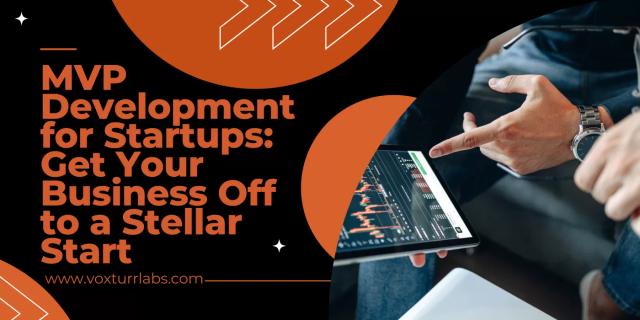
MVP
MVP Development for Startups: Get Your Business Off to a Stellar Start
It’s a fact that in this dynamic and turbulent world full of brilliant ideas ready to be born into great startups, every entrepreneur faces the same challenge – a blank page because they ignore MVP development! That is one of the primary reasons why about
9 min read
Start a conversation by filling the form
Once you let us know your requirement, our technical expert will schedule a call and discuss your idea in detail post sign of an NDA.